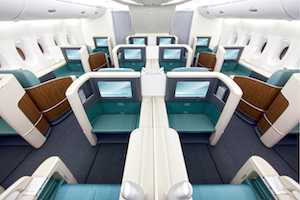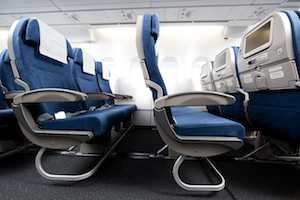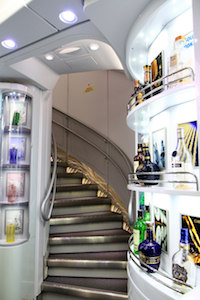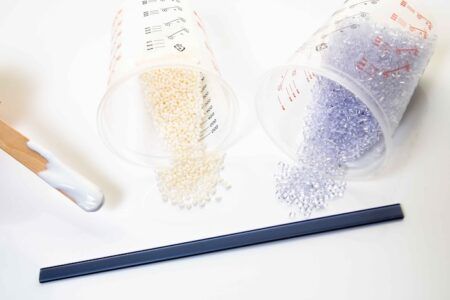The sheer size of the A380 offers airlines the opportunity to do something special with the cabin. Singapore Airlines (471 seats) got the ball rolling in October 2007 when it gave passengers private suites with seats and beds in first class, 34in-wide seats in business and led the way with office productivity functions on Panasonic’s eX2 IFE system.

Next up was Emirates (489 seats) in July 2008. The biggest customer for the A380 (with 90 orders), Emirates’ buying power enabled it to really go to town on a highly customised upper deck, designed by Jacques Pierrejean. Given over to the premium classes, it boasts suites, bars, a waterfall feature and, of course, those famous showers.
The third A380 (450 seats) followed soon after, delivered to Qantas in September 2008. Benefiting from the star power of Marc Newson at the helm, the interior is perhaps less showy than previous A380s, but oozes style and attention to detail. It is also the only A380 so far to include four classes – with the addition of premium economy.
The next A380 was the first for a European airline, Air France (538 seats). Delivered in October 2009, highlights include an art gallery on the upper deck. The fifth design (526 seats) was delivered to Lufthansa in May 2010. It boasts several firsts – including the first use of cabin humidification in a commercial airliner, and the first onboard urinals. It also has spacious bathrooms with changing zones by muller romca in first class, and extensive sound-dampening technology.
All this means that Korean Air, the sixth customer for the superjumbo, had a tough act to follow. It hasn’t disappointed. Unveiled in May 2011, Korean Air’s A380 is not only the most spacious of its class, with only 407 seats, it also boasts the world’s first onboard duty-free area, and stylish bars sponsored by mammoth vodka brand Absolut.
“With its spacious layout, the A380 is expected to further strengthen Korean Air’s competitiveness as a leading global carrier in the aviation industry,” said Lee Young Kuk, assistant manager of the airline’s inflight sales team.
Young Kuk stated that the airline hasn’t sacrificed seats to fit in the duty-free area and bars, but instead “just maximised the space resources in the rear side of the A380”.
 The carrier is also the first to dedicate the top deck entirely to one class – decked out as it is with 94 business-class seats, plus two bars. The business-class model is the Prestige Sleeper from B/E Aerospace, a full-flat product configured at 74in pitch and 21.6in width.
The carrier is also the first to dedicate the top deck entirely to one class – decked out as it is with 94 business-class seats, plus two bars. The business-class model is the Prestige Sleeper from B/E Aerospace, a full-flat product configured at 74in pitch and 21.6in width.
 The main deck has 12 first-class and 301 economy-class seats. The new economy seating from Weber offers 118° recline, 34in pitch and 18in width. All classes feature Panasonic’s eX2 IFE, with 23in screens in first, 15.4in for business and 10.6in in economy. Meanwhile, in first class, the Kosmo Suite boasts 83in pitch and 27in width and transforms into a fully flat bed. It also features on the airline’s refurbished Boeing 777s.
The main deck has 12 first-class and 301 economy-class seats. The new economy seating from Weber offers 118° recline, 34in pitch and 18in width. All classes feature Panasonic’s eX2 IFE, with 23in screens in first, 15.4in for business and 10.6in in economy. Meanwhile, in first class, the Kosmo Suite boasts 83in pitch and 27in width and transforms into a fully flat bed. It also features on the airline’s refurbished Boeing 777s.
Retail therapy
 The duty-free area is located at the back of the main cabin. Its main function is to showcase the airline’s duty-free offering, enabling passengers to get hands on with items including high-end cosmetics, fragrances, alcohol and accessories.
The duty-free area is located at the back of the main cabin. Its main function is to showcase the airline’s duty-free offering, enabling passengers to get hands on with items including high-end cosmetics, fragrances, alcohol and accessories.
“We believe that the Korean Air Duty Free Showcase will make our passengers’ flying experience even more enjoyable,” said Young Kuk. “Passengers can now appreciate the duty-free offering – they can check the size of items and the colour of cosmetics, and handle accessories.”
 Up to 64 items can be displayed at one time. Designed by AIM Aviation, the area includes magnetic shelves to prevent the luxury products sliding around during takeoff and turbulence. Magnets are glued to the bottom of display items to adhere them to the shelves.
Up to 64 items can be displayed at one time. Designed by AIM Aviation, the area includes magnetic shelves to prevent the luxury products sliding around during takeoff and turbulence. Magnets are glued to the bottom of display items to adhere them to the shelves.
The airline estimates that each display monument adds around 130kg in weight, plus 30kg for the display items. Korean Air conducts all its duty-free transactions in full in flight, so it has to carry all the items it intends to sell on the aircraft, rather than storing them at each destination. As such, storage is included as part of the area.
Of course, all this bumps up the weight of the aircraft, but perhaps this cost will be outweighed by ancillary revenue – only time will tell. The airline certainly has an extremely successful track record in inflight sales, and is believed to have made in excess of US$200 million from it in 2010. “Korean Air is the world’s most successful airline in terms of inflight retail,” stated Young Kuk.
Bar work
 Meanwhile, Heath Tecna created two bar/lounges for the top deck, both sponsored by Absolut Vodka. “The partnership between Absolut and Korean Air is backed by a long tradition so this new collaboration was a logical next step,” said Young Kuk. “Absolut is famous for its innovative and groundbreaking initiatives in the duty-free/travel retail market. It’s a brand that represents all the cutting-edge values of quality, exclusivity, creativity and innovation that are also core to Korean Air.”
Meanwhile, Heath Tecna created two bar/lounges for the top deck, both sponsored by Absolut Vodka. “The partnership between Absolut and Korean Air is backed by a long tradition so this new collaboration was a logical next step,” said Young Kuk. “Absolut is famous for its innovative and groundbreaking initiatives in the duty-free/travel retail market. It’s a brand that represents all the cutting-edge values of quality, exclusivity, creativity and innovation that are also core to Korean Air.”
The forward lounge includes a four-person sofa with built-in side tables and reading lamps; a magazine display, which also doubles as an amenity/snack serving area; and a self-service Absolut-themed bar featuring a display tower, martini glasses and chilled liquor bottles stored in a conjoined side table.
The aft lounge, appropriately called the Celestial Bar, is even more elaborate. Staffed full time with a bartender, and at the cost of around three seating rows, it incorporates a two-person sofa with reading lamps, a trio of lean-to cushions, a flat-panel LCD on top of a magazine display, and a stand-up bar. Both the lounges are finished in blue fabrics, high-gloss white paint, powder-coated aluminium surfaces, accent lighting and a special squirrel and grape leaf decorative motif.
Heath Tecna’s contract calls for the company to coordinate the design – incorporating input from Absolut and Airbus as well as the airline. It also had to build mock-ups, engineer the designs to pass certification and manufacture the equipment. The programme kicked off in 2006; shipsets will support Korean Air’s A380 deliveries through 2014. Heath Tecna is also supplying centreline stowage closets for the top of the forward stairway. For every Korean Air A380 built, Heath Tecna supplies nine cabin furnishing assemblies, which will total 90 units over the course of the programme.
All in all, it’s clear Korean Air means to make a splash with its flagship. “Korean Air was the first airline to purchase an Airbus aircraft outside Europe and they have now become an essential part of our fleet,” said Yang Ho Cho, chairman and CEO of Korean Air, on receiving the first of its A380s. “The exceptional, fuel efficient and environmentally friendly A380 that is being delivered today is perfect to assist Korean Air in advancing our goal of becoming a respected leading global carrier.”





